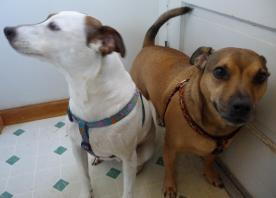What Type of Collar or Harness Should I Use to Walk My Dog?
- posted: Mar. 18, 2018
 What Type of Collar or Harness is Best for my Dog?
What Type of Collar or Harness is Best for my Dog?
With the first day of spring arriving this week, warm weather is hopefully coming soon to South Central Pennsylvania despite some late season snow. When it does, many of us will be out walking our dogs. There are many different types of collars and harnesses (in lovely spring collars, no doubt!) but how do you know which one is the best fit for your dog?
If your pet is a strong puller, a head collar is your best bet. A head collar looks a little like a horse harness. It fits around the muzzle and clips behind the head, but it does not keep the mouth closed like a true muzzle. There are a few different brands: the HaltiR and the Gentle LeaderR are two of the most popular. These provide excellent control of the dog’s head and discourage pulling. There may be a learning curve to getting your furry friend comfortable with wearing this type of collar, and most dogs will try to remove them when they have “down time” but these types of collars are good for most dogs except for those with short snouts.
A harness that fits around the chest is a good choice for brachycephalic breeds such as Bulldogs or Pugs, small breed dogs such as Chihuahuas or Pomeranians or any dog with medial issues such as collapsing trachea or back or neck injuries. Dogs with glaucoma should also wear harnesses as pressure on the neck can increase pressure within the eyes. A harness does not necessarily stop a dog from pulling, but it does distribute the weight across the chest instead of around the neck like a traditional collar, and there are many different styles. Incidentally, some cats can also be trained to walk with a leash and harness.
The Martingale collar is a type of wide fabric slip collar most often associated with Greyhounds. Because of their large necks and smaller heads, the Martingale is a padded collar that tightens if the Greyhound pulls forward, so it will not slip over the head. Think of them as being similar to, but much gentler than a choke-chain collar. These collars can be used on any type of dog, but are not the best option for strong pullers.
Metal choke-chain collars and prong collars are not recommended for walking and should really be used only for training purposes as dogs can injure their tracheas if they pull against the metal chain. They are meant to be used as a quick pull and release to get the dog’s attention and stop an unwanted behavior.
A regular nylon or leather collar that fits around the neck can be used for well-trained dogs that do not pull or in conjunction with other collars to provide an added element of safety and to hold ID tags. Make sure collars are not too tight or too loose around the neck. The rule of thumb is that you should be able to comfortably fit two fingers under the collar.
Hopefully, this guide will help you choose a collar or harness that works best for your dog’s breed and energy level. Let’s all think warm thoughts for spring so our pets can sport those new collars and leads while walking!
This blog brought to you by the Patton Veterinary Hospital serving Red Lion, York and the surrounding communities.
Source: “Take the Lead.” Woman’s Day April. 2018. 128. Print
Location
Patton Veterinary Hospital
425 E Broadway
Red Lion, PA 17356
